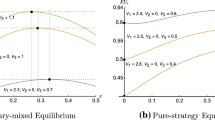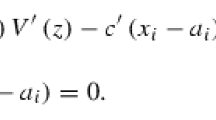Abstract
We show that the optimal prize structure of symmetric n-player Tullock tournaments assigns the entire prize pool to the winner, provided that a symmetric pure strategy equilibrium exists. If such an equilibrium fails to exist under the winner-take-all structure, we construct the optimal prize structure which improves existence conditions by dampening efforts. If no such optimal equilibrium exists, no symmetric pure strategy equilibrium induces positive efforts.
Similar content being viewed by others
References
Alcalde, J., & Dahm, M. (2010). Rent seeking and rent dissipation: A neutrality result. Journal of Public Economics, 94(1–2), 1–7.
Barut, Y., & Kovenock, D. (1998). The symmetric multiple prize all-pay auction with complete information. European Journal of Political Economy, 14, 627–644.
Baye, M. R., Kovenock, D., & de Vries, C. (1994). The solution to the Tullock rent-seeking game when R>2: Mixed-strategy equilibria and mean dissipation rates. Public Choice, 81, 363–380.
Baye, M. R., Kovenock, D., & de Vries, C. (1999). The incidence of overdissipation in rent-seeking contests. Public Choice, 99, 439–454.
Clark, D. J., & Riis, C. (1998). Influence and the discretionary allocation of several prizes. European Journal of Political Economy, 14, 605–625.
Cornes, R., & Hartley, R. (2005). Asymmetric contests with general technologies. Economic Theory, 26, 923–946.
Franke, J., Kanzow, C., Leininger, W., & Schwartz, A. (2009). Leveling the lobbying process: Effort maximization in asymmetric N-person contests (Working Paper #2744). CESifo.
Fu, Q., & Lu, J. (2007): Unifying contests: from noisy ranking to ratio-form contest success functions (MPRA Working Paper, 6679).
Fu, Q., & Lu, J. (2009). The beauty of bigness: On optimal design of multi-winner contests. Games and Economic Behavior, 66, 146–161.
Gershkov, A., & Perry, M. (2009). Tournaments with midterm reviews. Games and Economic Behavior, 66, 162–190.
Jia, H. (2008). A stochastic derivation of the ratio form of contest success functions. Public Choice, 135, 125–130.
Konrad, K. (2008). Strategy and dynamics in contests. Oxford: Oxford University Press.
Moldovanu, B., & Sela, A. (2001). The optimal allocation of prizes in contests. American Economic Review, 91(3), 542–558.
Siegel, R. (2009). All-pay contests. Econometrica, 77, 71–92.
Skaperdas, S. (1996). Contest success functions. Economic Theory, 7(2), 283–290.
Szidarovszky, F., & Okuguchi, K. (1997). On the existence and uniqueness of pure Nash equilibrium in rent-seeking games. Games and Economic Behavior, 18, 135–140.
Szymanski, S., & Valletti, T. M. (2005). Incentive effects of second prizes. European Journal of Political Economy, 21, 467–481.
Author information
Authors and Affiliations
Corresponding author
Rights and permissions
About this article
Cite this article
Schweinzer, P., Segev, E. The optimal prize structure of symmetric Tullock contests. Public Choice 153, 69–82 (2012). https://doi.org/10.1007/s11127-011-9774-2
Received:
Accepted:
Published:
Issue Date:
DOI: https://doi.org/10.1007/s11127-011-9774-2




